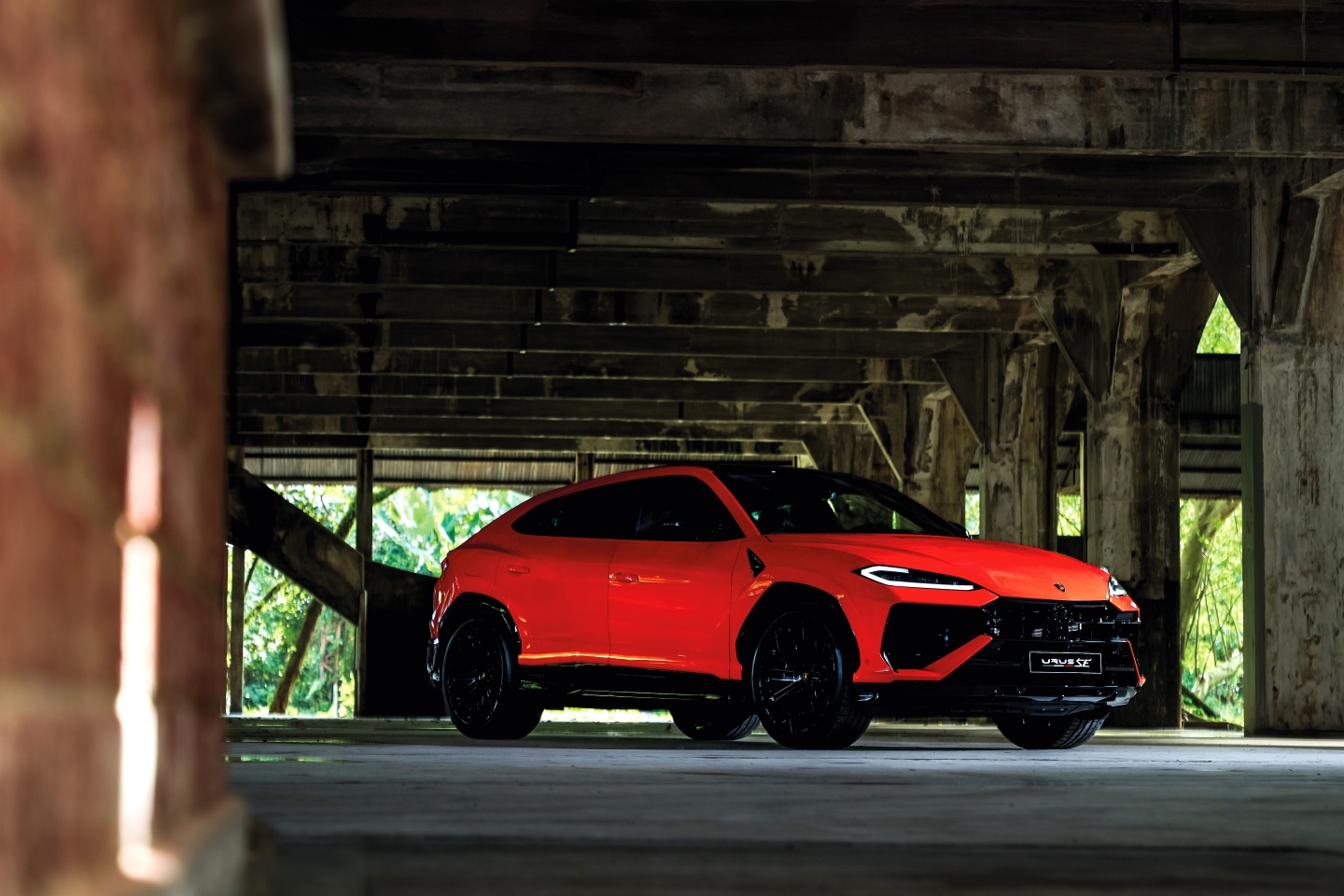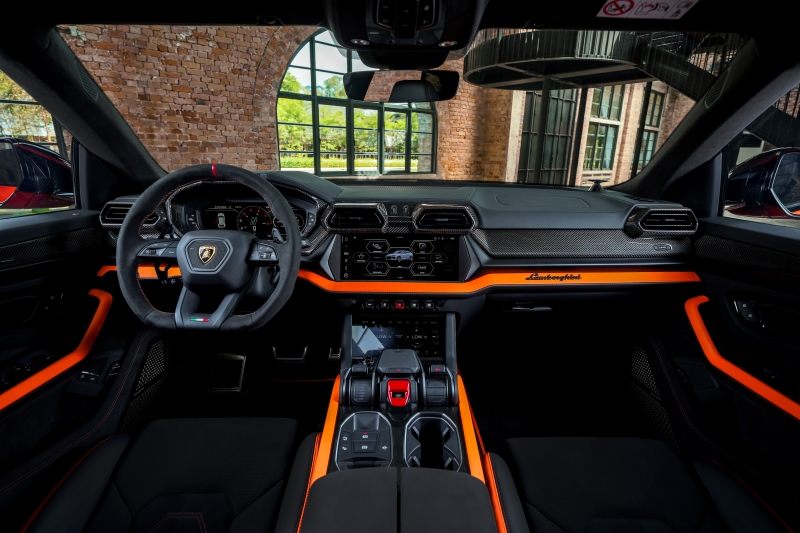
The Urus SE is updated with even niftier proportions that optimise aerodynamic efficiency (All photos: Lamborghini)
Following its seminal international debut at Auto China Beijing, the Urus SE, Lamborghini’s first hybrid plug-in version of its Super SUV, has finally reached Malaysian shores. The launch marks a historic milestone for the Italian carmaker as it progresses further with its decade-long electrification strategy.
Named Direzione Cor Tauri — Latin for “heart of the bull”, which also refers to the brightest star of the Taurus constellation — the transformation plan comprises three phases. The first celebrates the internal combustion engine, paying tribute to the brand’s glorious history and iconic products. The second, where we are currently, is when the vehicles begin to evolve. The Revuelto kick-started the hybridisation stage in 2023 and, this year, the Urus SE follows suit. Fans can also expect the hybrid successor of the Huracán to be launched in Q4. Phase three, planned for the second half of the decade, is where one can anticipate the introduction of a full electric vehicle (EV). The question is: What’s taking so long?
“The reason is we don’t want to be the first to get into electrification. We want to be the best,” says Francesco Scardaoni (pictured, bottom right), regional director for Asia-Pacific.
The rapid surge in demand for pure EVs can be largely attributed to changing customer values: A reduced reliance on fossil fuels is imperative.
But there is a difference between reacting and responding to market change. Lamborghini chose to sit back, observe and analyse first, taking time to understand consumer needs and steadily draw its bowstring so that the first EV arrow would hit the bullseye.
lamborghini_urus_se_launch_kuala_lumpur_10.jpg

The Urus SE is an exemplary indicator of how the Italian marque is treading on the right path. Optimised aerodynamics, unprecedented on-board technology, a refreshed design and a hybrid powertrain are all built on its Urus S predecessor. Thanks to its thermal and electric “hearts”, the torque and power values of the Urus SE are the highest ever with an 80% reduction in emissions.
“The Lamborghini hybridisation doesn’t mean there is a trade-off,” Scardaoni stresses. “When we design a hybrid, the brief given to our engineers is always to add new features. Additional comfort, fuel efficiency, performance, agility and drivability. There’s no compromise in hybridisation. It’s developing a better and faster car than the one before.”
The twin-turbo 4.0 V8 engine has been re-engineered to work in complete harmony with the electric powertrain. Together, it generates a total output of 800CV (588kW) of power at 6000rpm with a total torque of 950Nm already available at 1750rpm and up to 5750rpm. The Urus SE sprints from 0 to 100kph in just 3.4 seconds and boasts a top speed of 312kph, making it the fastest production car in the segment of Super SUVs.
Besides acting as a boost for the V8 combustion engine, the permanent-magnet synchronous electric motor can also serve as a traction element, making the Urus SE a 100% electric 4WD vehicle capable of travelling more than 60km in EV mode. While we are on the topic, the six Urus driving modes — Strada, Sport, Corsa, Neve, Sabbia and Terra — are now accompanied by four new electric performance strategies: EV Drive, Hybrid, Performance and Recharge, allowing a more dynamic range of driving experiences whether you are on the road, track or off the asphalt.
The hybrid model also debuts a centrally-located longitudinal electric torque vectoring system with an electro-hydraulic multi-plane clutch, which distributes driving torque variably and continuously between the front and rear axles.
lamborghini_urus_se_launch_kuala_lumpur_8.jpg

“Thanks to torque vectoring, we can create the kind of performance that is not only better but also more agile and stable,” Scardaoni elaborates. This gives the SUV “on-demand” oversteering to convey the feel of a pure-bred super sports car.
In terms of design, the Urus SE is updated with even niftier proportions that optimise aerodynamic efficiency. New elements include a redesigned floating bonnet, headlight clusters featuring matrix LED technology, a revised bumper, a front grille and a tail lamp grille inspired by the Gallardo.
Together with the revamped spoiler, the diffuser increases the PHEV Super SUV’s rear downforce by 35% at high speeds compared to the Urus S, enhancing its stability. New underbody air vents and air ducts also improve aerodynamic efficiency while channelling more airflow to cool the mechanical components.
Inside, the cabin has been updated to further embody Lamborghini’s “Feel Like a Pilot” philosophy, enhancing the interaction between the driver and the vehicle’s digital system. The designers focused on accentuating a lightweight feeling with elements such as anodised aluminium trim details, a new panel, seat and dashboard coverings. A 12.3in screen gives access to the more intuitive Human Machine Interface, the same infotainment system that debuted on the Revuelto.
“When we introduced the first-generation Urus in 2018, it was an amazing success. Seventy per cent of customers were new to the brand,” Scardaoni recalls. “They eventually got to know more about Lamborghini and our other products. Some have also become owners of super sports cars. There are many young customers who will not even sit in the dealership if the product is not sustainable. So, we believe with this car, we can also get a new audience.”
The numbers look promising.
“Our 2025 production is basically sold. The success of the Urus SE is starting to be visible and we’re pretty happy with the immediate reaction from the market.”
lamborghini_urus_se_launch_kl_francesco_scardaoni_al_apac_region_director_11.jpg

Lamborghini is pursuing the target of reducing CO2 emissions by 50%, so from 2025 onwards, all its products will be hybridised. Last year, at the 72nd edition of the Pebble Beach Concours d’Elegance (which autophiles consider the world’s most prestigious car show), the brand unveiled the concept car of its future pure electric model. “Named Lanzador, it is based on a different body type, which we call the Ultra GT. It is not a crossover because it has more of the lines of a GT, but it’s not a GT because it has the height of a crossover. Two-door, four seats. And this car will only be introduced from 2028.”
Scardaoni refers to the current stage as a “hybrid bridge between yesterday and tomorrow” that will give the brand more time to fully understand customer needs and the technology required to produce a pure EV worthy of the bull’s crest.
“What we already understand is that our customers require an ‘emotional’ car. Emotion will be one of the key factors in getting into the EV. If I blindfold and put you inside the Lanzador, you will have to feel like you’re driving a Lamborghini in terms of performance, handling, comfort and emotion.
“Emotion is also, of course, made of sound. But with an electric car, it won’t be the same as that made by a combustion engine. This is what we’re really focusing on. What we can say today is we will for sure not be replicating any sound from the internal combustion engine. We will not fake any of that.”
A futuristic tune dedicated to the Lanzador, perhaps?
A name synonymous with high-octane combustion engines, Lamborghini’s move to electric cars is a big turning point for luxury and high-performance vehicles, stressing the seriousness of the industry’s shift towards sustainable solutions. But until that day arrives, the marque continues to instil confidence with phenomenal releases like the Urus SE in which one can still get the best of both worlds.
The Lamborghini Urus SE is open for booking with a starting price of RM1,028,000 before taxes, duties and customisation.
This article first appeared on June 24, 2024 in The Edge Malaysia.


